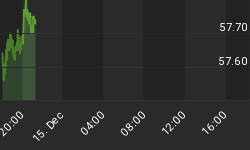As discussed in my previous commentary entitled, "Has Santa Clause already passed Wall Street by?", the broad market has likely topped, short-term, and a decline appears imminent. This will thrown the proverbial monkey wrench in Wall Street's long cherished tradition of the "Santa Clause Rally." In other words, it looks as if Santa has indeed passed Wall Street by this holiday season and instead of toys and candy, only coal and ashes are being left behind for investors who are heavily exposed to the long side of the market right now.
Ironically, the old "tried and true" technical indicators and seasonal biases that worked consistently in the previous century are no longer working with the same consistency in the new millennium. We've touched on this before as it concerns, among other things, the peak in the 30-year cycle around the year 2000. More recently, the 20-year cycle peaked in October (I plan to address this extensively in a future article). Suffice it to say that traders and investors who hang their hat on the old market truisms from the past century are going to be disappointed at times from here on out as a "new reality" is being established in the stock market. This would include the traditional December bullish bias, which until now has been viewed as an immutable law.
Let's turn our attention to something we haven't looked at in a while -- yields. Our previous yield analysis in the leading stocks and indices earlier this summer gave us clues about the dominant intermediate-term bottom at that time, and I believe we once again have a message (short-term) in the yield trend of the Dow and S&P.
As a refresher, a rising yield trend in a stock or stock index as price is falling will eventually result in a turnaround, especially when the yield reaches a pivotal benchmark that has resulted in price reversals in the past. Conversely, a falling yield trend that accompanies a rise in price will eventually result in a reversal of price when the yield reaches a pivotal low point.
The yield on the S&P 500 (SPX) is currently 1.56% and this is a pivotal low for the past year. On two other occasions this year, whenever the yield on the SPX fell to around 1.55-1.60 it corresponded with a short-term top in the SPX itself and was followed by a downside correction. This happened back in April when the yield on the SPX fell to around 1.60 and the SPX price line fell from its early April high around 1150 to its May low of 1080. Of course this was a fairly big hit for the SPX then due to a confluence of cycle peaks around that time (not to mention the negative influence of the 10-year cycle which was in the process of coming down hard back then).
The only other time this year the yield on the S&P fell to around 1.60 was in mid-to-late June when the SPX was around the 1140 area. It subsequently fell to its August low of 1065, the low for the year.
Currently, the S&P is slightly below the psychological 1200 level and the yield has made a new low for the year. At current levels, this suggests corrective pullback (mentioned above) in the immediate-term for the broad market. In the Dow 30 index the yield is currently 2.01%. This pretty much ties the yield at the previous short-term top in early September. At that time the stochastics indicator was making lower lows, as it is now, and the MACD indicator was just about to cross over on the downside. This has already happened this month, so the weight of evidence is that a short-term correction is imminent.
From the standpoint of market psychology, a recent perusal of the Financial Times newspapers the past few days has yielded an interesting twist to our constantly updated "fear collage." Only instead of fear we see the opposite, namely, optimism. Perhaps I should call it an "optimism collage" at times like this. Anyway, here's a sampling of the latest headlines that I ran across:
"Bulls see falls as precursor to an end-of-year rally," "Buying sprees buoy traders' festive cheer," "Companies optimistic on jobs outlook," "Fear not, be guided by the dollar," "Strong U.S. growth 'for 10 more years,'" "Rise in U.S. retail sales calms fears of a slowdown," "Oil rises as Saudi output cuts go ahead."
The latter headline was accompanied by a prominent graph showing the past year's trend in the crude oil price, with special emphasis to the most recent 2-month decline. This calling of attention to the oil price slide down to around $40 (which was predicted here earlier this fall) reflects an immediate-term bottom and turnaround in the oil price from a contrarian standpoint and that's exactly what has happened this week with oil rallying rather sharply the past couple of days. Since peaking at around $56 in October, the crude oil price has come well off its high for the year and has essentially returned to trend line around the $40 area. This represents roughly a 62% retracement of the longer-term bull market advance in crude in just a matter of weeks.

Back to the broad market. The 1200 level is very pivotal in the S&P 500 (SPX) as it represents the top of a 4 ½ -month uptrend channel. The previous four times the SPX has tested this upper boundary of the trend channel has resulted in a corrective pullback, and my expectation is that this time will prove no different. This minor breakout above 1200 earlier in the week followed by the failure to follow through actually represents exhaustion of the immediate-term trend and is usually followed by a corrective decline.















